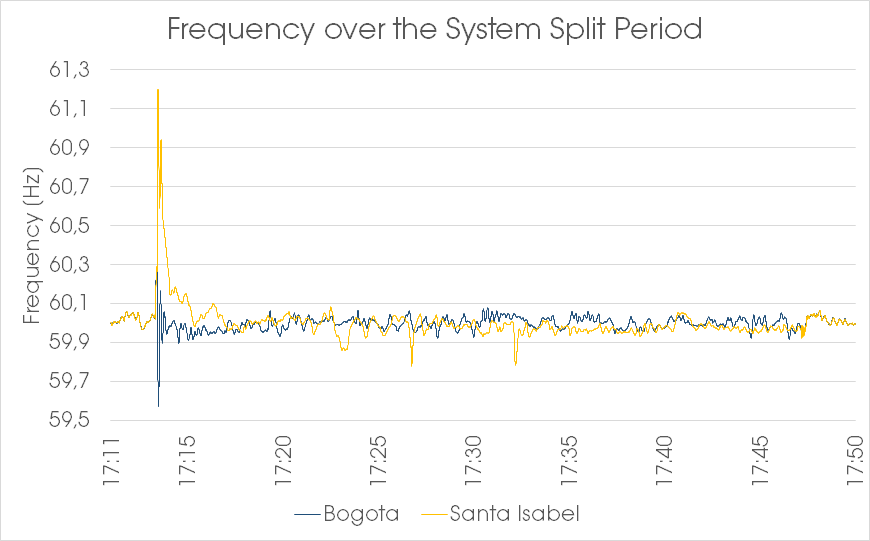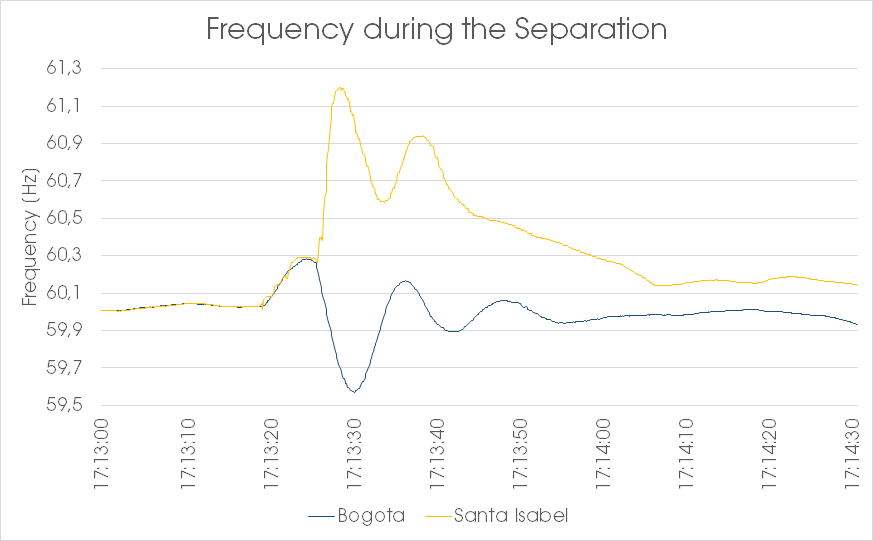System split due to the Earthquake in Ecuador
According to the Geological Institute of Ecuador (IG), several earthquakes occurred off the northwest coast of South America at around 17:13 (UTC) on Saturday, 18 March 2023. The strongest quake reached a value of 6.8 on the Richter scale and had its centre around 35 km off the coast of Balao on the border between Ecuador and Peru (see for example die Zeit).
The System Split
The earthquake also directly affected the power grids of Ecuador and Colombia: As Figure 1 shows, there was a grid split between the two countries of just over half an hour.

Figure 1: Frequency development during the period of the system split
According to Figure 2, the grid frequency before the earthquake in the grids of Ecuador and Colombia moved fairly in step around the target frequency of 60 Hz. After 17:13:15, there was a massive increase in the grid frequency to 60.29 Hz within about 4 seconds. This increase can probably be explained by the fact that large consumption units were disconnected from the grid almost simultaneously due to automatic safety shutdowns in connection with the earthquakes. Power plants, on the other hand, remained connected to the grid. This presumably led to the short‐term increase in frequency with the consequence of the system split.

Figure 2: Frequency development during the separation
Due to the system split, the grid frequency in Bogotá, Colombia, dropped below 59.6 Hz. In Santa Isabel, Ecuador, the grid frequency rose further to 61.2 Hz. This clash of grid frequency during a system split is not unusual. As we already observed during the grid split on 24.07.2021 between France and Spain, the grid frequency increases in the exporting region while it decreases in the importing region as a result of a generation shortfall.
This finding indicates that before the system split, there was a flow of energy from Ecuador to Colombia. The system split following the earthquake abruptly separated the two grid regions, resulting in too much energy in the southern region and too little in the northern region. The system split in South America resulted in two similarly sized grid regions in terms of the pending flywheel masses. This can be deduced from the frequency deviations in both regions. This is because they are similarly pronounced.
Unlike the European system split, however, the undersupplied region stabilised around 60 Hz again relatively quickly. The oversupplied region also returned to around 60 Hz within about 1.5 minutes. The system split shows, however, that the grids in both regions were individually much more unstable than before the split.
The Resynchronisation

Figure 3: Frequency during the resynchronisation
Figure 3 shows the resynchronisation. After about 34 minutes, at 17:47:10 (UTC), both grid regions were reconnected. This resulted in a swing in both grids, whereby the swing in the south was stronger than that in the north. It can be assumed that there were fewer swinging masses on the grid in the south at this time than in the Colombian grid region. Swinging masses dampen such pendulum movements. Only about 1 minute after synchronisation did the frequency curves return to synchronous development.
Background
The power grids of Ecuador and Colombia have been synchronised since 2003 as part of the Andean Electrical Interconnection System (SINEA) via 230 kV lines. The nominal frequency is 60 Hz. Gridradar operates two measuring stations in Ecuador and in Colombia. Further information about the synchronous area and the project, which also synchronises other grid areas in South America in addition to Ecuador and Colombia, can be found for example here.
